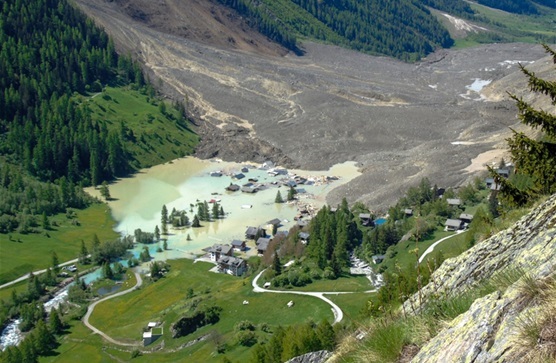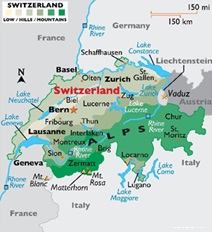(Prelims: Current Affairs, World Geography)
(Mains Paper 3: Disasters and Disaster Management.) |
Reference
On May 28, 2025, a huge chunk of the Birch Glacier broke off and slid down the mountain slope in the alpine village of Blatten, located in the Lötschental Valley in southern Switzerland, burying nearly 90% of the village under debris.

Causes of Blatten Landslide
The landslide in Blatten was caused by the instability of the Birch Glacier, which has been linked to climate change. The following factors were responsible for this:
- Glacier retreat and melting of permafrost: Global warming has accelerated the retreat of glaciers in Switzerland. Melting of permafrost, which binds rocks and soil in high-altitude areas, has reduced slope stability.
- However, in Blaten, two weeks before the disaster scientists had observed instability of rocks above the Birch Glacier, where rocks were breaking off and piling up on the glacier.
- Increased water seepage: Higher temperatures have increased the availability of water due to melting of snow and ice, as well as increased rainfall. This in turn has led to increased weathering processes, which in turn promotes erosion.
- Role of climate change: According to Mylene Jacquemart, physical geographer and remote sensing expert, although it is not clear whether this disaster can be completely linked to climate change, rising temperatures are making high-altitude landscapes more unstable. Melting of snow and ice and increased rainfall have further accelerated this process.
Impact of Blaten disaster
- Human losses have been almost zero due to pre-disaster safety measures.
- 90% of the village was buried under debris, destroying local infrastructure, homes and livelihoods.
- The region, known for its natural beauty and tourism, will now struggle for a long time for economic recovery.
Environmental risks
- Landslide debris blocked the flow of the Lonja River, forming an artificial lake.
- This lake is filling at a rate of 80 centimetres per hour.
- If the debris barrier breaks, there is a risk of massive flooding in the Lonja Valley that will negatively impact surrounding areas.
Policy implications
- Disaster management: Timely evacuation in Blaten avoided mass casualties, which is an example of effective disaster management.
- However, the debris barrier formed on the Lonja River and the potential flooding threat show that disaster management requires constant monitoring and rapid response.
- Climate change adaptation: The retreat of glaciers and the melting of permafrost are increasing the risk of landslides and floods in alpine regions.
- Governments need to strengthen infrastructure, enhance monitoring systems in at-risk areas, and implement rehabilitation plans for affected communities.
- Global cooperation: Climate change is a global challenge. The Blaten incident is also relevant for countries like India, where glaciers are melting and landslides are increasing in the Himalayan regions.
- International cooperation, such as the Paris Agreement, needs to be further strengthened to mitigate the effects of climate change.
- Sustainable development: Disasters in tourism-dependent regions like Blaten affect economic stability.
- Promoting climate-resilient infrastructure and alternative livelihood opportunities is essential for sustainable development.
Conclusion
The Blaten landslide is a grim reminder of the increasing risks in high-altitude regions due to climate change. This disaster not only highlights the need for immediate relief and rehabilitation, but also underscores the urgent need for long-term climate adaptation and disaster management strategies.
|
Also read!
About Switzerland

- Introduction: It is a landlocked country located in Western Europe.
- Capital: Bern
- Largest city: Zurich
- Borders: Shares border with a total of 5 countries.
- Germany, France, Italy, Austria, Liechtenstein
- Geographical features
- Alps are located in its south and Jura Mountains in the west. Both of these are examples of folded mountains.
- Alps is the highest mountain range in Europe, its highest peak is Mont Blanc.
- Jura mountain range is mainly located on the border of France, Switzerland and Germany.
- Major rivers: Rhine River, Rhône River, Aare River
|



